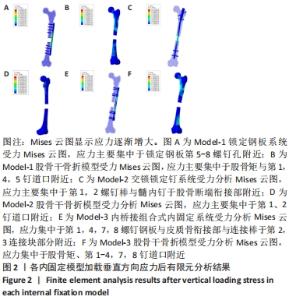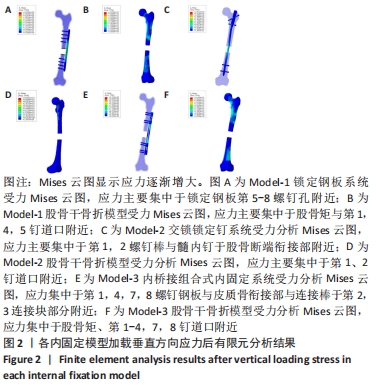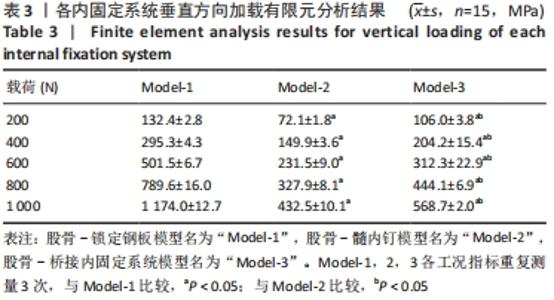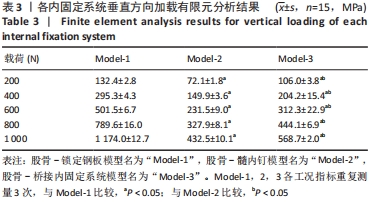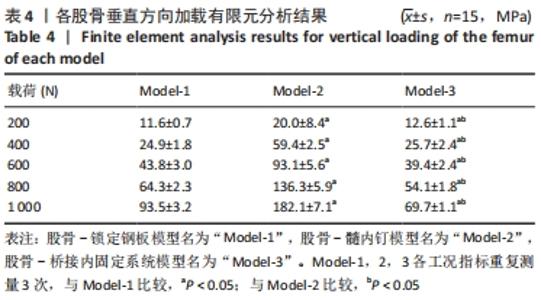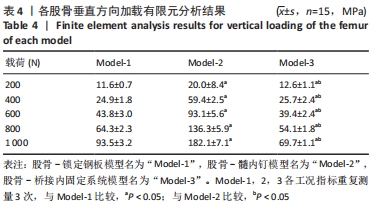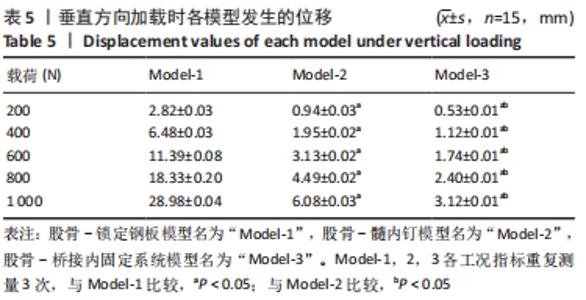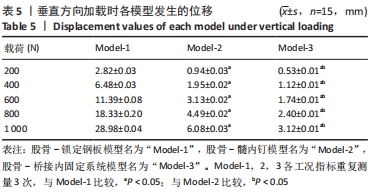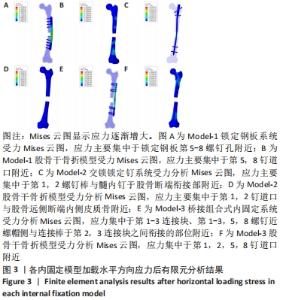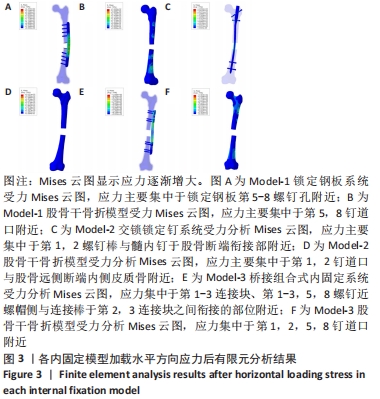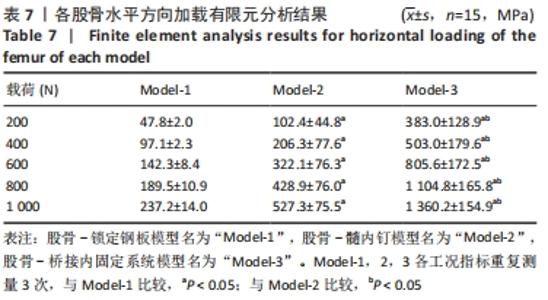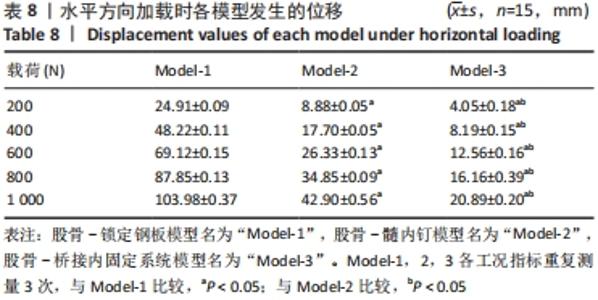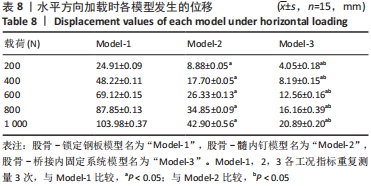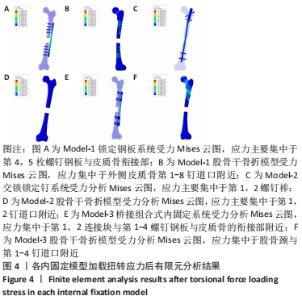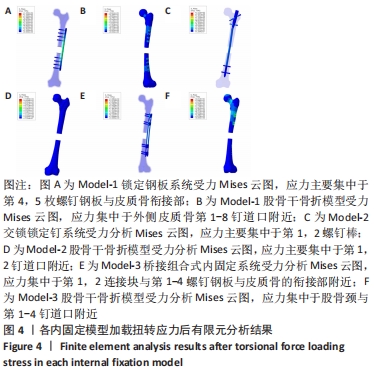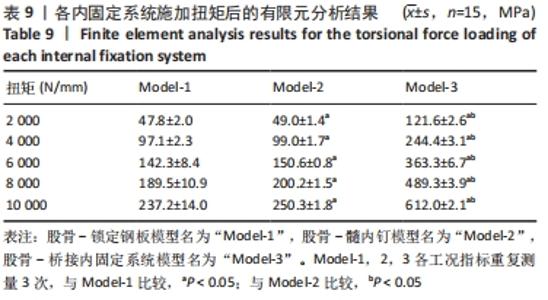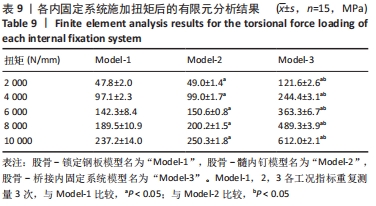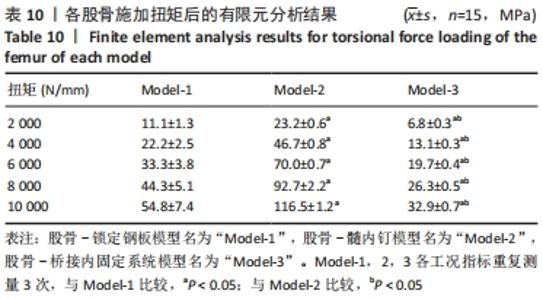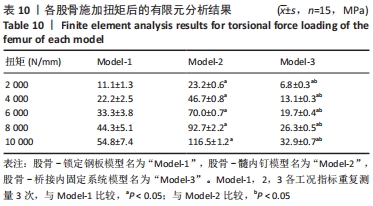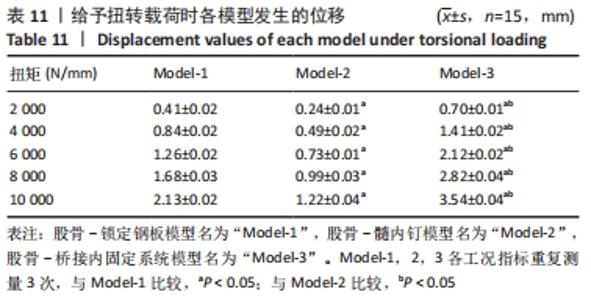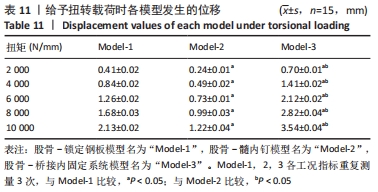Chinese Journal of Tissue Engineering Research ›› 2022, Vol. 26 ›› Issue (33): 5271-5277.doi: 10.12307/2022.717
Previous Articles Next Articles
Finite element analysis of three internal fixation methods for treating femoral shaft fracture
Xu Zhi1, Zhong Hehe2, Xiang Hao3, Li Enchao4, Huang Yushun4, Lu Hao1, Jin Ying2, Zou Gang2, Liu Yi2
- 1Department of Orthopedics, Zhangjiagang Fifth People’s Hospital, Zhangjiagang 215600, Jiangsu Province, China; 2Department of Orthopedics, Affiliated Hospital of Zunyi Medical University, Zunyi 563000, Guizhou Province, China; 3Department of Emergency, First People’s Hospital of Zunyi, Zunyi 563000, Guizhou Province, China; 4Department of Orthopedics, Jen Ching Memorial Hospital, Kunshan 215300, Jiangsu Province, China
-
Received:2021-09-29Accepted:2021-11-11Online:2022-11-28Published:2022-03-30 -
Contact:Liu Yi, Master, Chief physician, Department of Orthopedics, Affiliated Hospital of Zunyi Medical University, Zunyi 563000, Guizhou Province, China -
About author:Xu Zhi, Master, Physician, Department of Orthopedics, Zhangjiagang Fifth People’s Hospital, Zhangjiagang 215600, Jiangsu Province, China -
Supported by:Project of Science and Technology Foundation of Guizhou Provincial Health Commission, No. gzwkj2021-257 (to ZHH); Natural Science Foundation Project of Guizhou Province, No. [2017]7015 (to ZG); Master's Scientific Research Start-Up Fund Project of Zunyi Medical University, No. [2016]34 (to JY)
CLC Number:
Cite this article
Xu Zhi, Zhong Hehe, Xiang Hao, Li Enchao, Huang Yushun, Lu Hao, Jin Ying, Zou Gang, Liu Yi. Finite element analysis of three internal fixation methods for treating femoral shaft fracture[J]. Chinese Journal of Tissue Engineering Research, 2022, 26(33): 5271-5277.
share this article
Add to citation manager EndNote|Reference Manager|ProCite|BibTeX|RefWorks
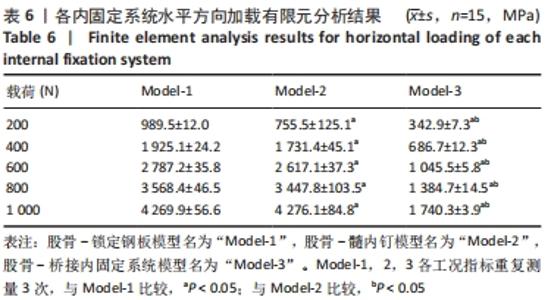
在Model-1中,锁定钢板内固定系统的承受应力强度为2 787.2 MPa,见图3A。股骨模型承受平均应力强度为142.3 MPa,见图3B。在Model-2中,交锁髓内钉系统的承受应力强度为2 617.1 MPa,见图3C,股骨模型承受平均应力强度为322.1 MPa,见图3D。在Model-3中,桥接组合式内固定系统的承受应力强度为1 045.5 MPa,见图3E,股骨模型承受平均应力强度为805.6 MPa,见图3F。 Model-1,2,3模型中内固定系统承载平均值分别为:2 787.2,2 617.1,1 045.5 MPa,此3个模型中内固定系统之间承受载荷的差异有显著性意义(P < 0.05),见表6。"
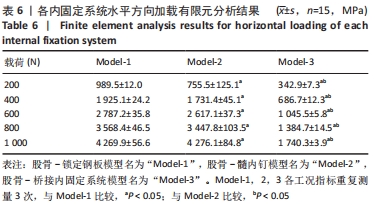
| [1] VAIDYA R, DIMOVSKI R, CIZMIC Z, et al. Use of Inherent anteversion of an intramedullary nail to avoid malrotation in comminuted femur fractures: a prospective case-control study. J Orthop Trauma. 2018;32(12):623-628. [2] 张庆杰,王永清,周星衡,等.锁定多向带锁髓内钉与锁定接骨板固定胫骨平台骨折的有限元分析[J].中华创伤骨科杂志,2015,17(3):251-256. [3] 吕志强,李兴华,王爱国.桥接组合式内固定与金属锁定接骨板钉系统修复股骨干骨折的生物力学比较[J].中国组织工程研究,2016,20(17):2555-2561. [4] 黄飞,赖爱宁,于凤宾,等.股骨干多节段骨折选择桥接组合式内固定系统治疗的疗效分析[J].中国骨与关节损伤杂志,2019,34(2):161-163. [5] 徐永清,吴一凡,熊鹰,等.桥接组合式内固定系统治疗四肢骨折[J].中华创伤骨科杂志,2018,20(6):465-469. [6] WANG DX, XIONG Y, DENG H, et al. Biomechanical analysis and clinical effects of bridge combined fixation system for femoral fractures. Proc Inst Mech Eng H. 2014;228(9):899-907. [7] 汪亮,于娇娜,黄朝朝,等.桥接系统混棒结构治疗股骨干长节段粉粹性骨折的生物力学研究[J].中华医学杂志,2019,99(34):2706-2710. [8] 史小全,白临奇,孙雅洲,等.基于有限元法的骨组织工程支架力学性能分析及改进设计[J].医用生物力学,2019,34(3):262-267. [9] 钟俊青,胡永成.股骨干近端组配式假体的设计及生物力学分析[J].中国组织工程研究,2019,23(12):1893-1897. [10] HAO LS, GUAN T, HUANG F, et al. Finite element analysis of InterTan for the treatment of femoral intertrochanteric fractures. Zhongguo Gu Shang. 2019;32(2):176-180. [11] LI J, HAN L, ZHANG H, et al. Medial sustainable nail versus proximal Femoral nail antirotation in treating AO/OTA 31-A2.3 fractures: finite element analysis and biomechanical evaluation. Injury. 2019;50(3): 648-656. [12] NIE SB, ZHAO YP, LI JT, et al. Medial support nail and proximal femoral nail antirotation in the treatment of reverse obliquity inter-trochanteric fractures (Arbeitsgemeinschaft fur Osteosynthesfrogen/Orthopedic Trauma Association 31-A3.1): a finite-element analysis. Chin Med J (Engl). 2020;133(22):2682-2687. [13] TUCKER SM, WEE H, FOX E, et al. Parametric finite element analysis of intramedullary nail fixation of proximal femur fractures. J Orthop Res. 2019;37(11):2358-2366. [14] 邓存宁.DHS治疗老年股骨粗隆间骨折80例临床分析[J].中国医药指南,2008, 9:93-94. [15] COQUIM J, CLEMENZI J, SALAHI M, et al. Biomechanical analysis using fea and experiments of metal plate and bone strut repair of a femur midshaft segmental defect. BioMed Res Int. 2018;2018:4650308. [16] ZHANG W, HAO M, CHANG Z, et al. Comparison of a multidimensional cross locking plate versus a locking compression plate for the treatment of femoral shaft nonunion: finite element analysis. Med Eng Phys. 2020; 83:106-111. [17] 张克飞.股骨干骨折120例临床治疗体会[J].中国现代药物应用,2013,7(11):46. [18] GRUBOR P, MITKOVIĆ M, MITKOVIĆ M, et al. Comparison of biomechanical stability of osteosynthesis materials in long bone fractures. Med Glas (Zenica). 2019;16(1): 88-92. [19] ZHANG W, ZHANG Z, CHEN H. Research progress of augmentation plate for femoral shaft nonunion after intramedullary nail fixation. Zhongguo Xiu Fu Chong Jian Wai Ke Za Zhi. 2019;33(12):1467-1473. [20] HERRERA A, ROSELL J, IBARZ E, et al. Biomechanical analysis of the stability of anterograde reamed intramedullary nails in femoral spiral fractures. Injury. 2020; 51(1):74-79. [21] CHEN F, ZHAO Z, GAO C, et al. Clustering of Morphological Features for Identifying Femur Cavity Subtypes With Difficulties of Intramedullary Nail Implantation. IEEE J Biomed Health Inform. 2018;22(4):1209-1217. [22] 王汉卿,楼跃,王浩然.交锁髓内钉与锁定加压钢板治疗大龄儿童股骨干骨折的有限元分析[J].实用临床医药杂志,2020,24(20):6-10. [23] 张伟,陈华,唐佩福.股骨干无菌性骨不连的最新治疗进展[J].中国修复重建外科杂志,2018,32(5):519-525. [24] 张伟,聂少波,吴韬光,等.不同附加钢板治疗股骨干髓内钉固定术后骨不连的生物力学比较研究[J].中华创伤骨科杂志,2020,22(9):788-792. [25] 王兆林,曹斌.交锁髓内钉与微动[J].中华创伤骨科杂志,2004,6(5):575-577. [26] DÉJARDIN LM, PERRY KL, VON PFEIL DJF, et al. Interlocking nails and minimally invasive osteosynthesis. Vet Clin North Am Small Anim Pract. 2020;50(1):67-100. [27] 李栋,周维波,朱春晖,等.桥接组合式内固定系统和锁定钢板系统治疗股骨干骨折的疗效比较[J].中国微创外科杂志,2020,20(9): 807-811. [28] 郭龙,朱新宏,于凤宾,等.桥接系统治疗严重粉碎性股骨骨折[J].中国骨伤, 2020,33(4):332-336. [29] KANG L, LIU H, DING Z, et al. Ipsilateral proximal and shaft femoral fractures treated with bridge-link type combined fixation system. J Orthop Surg Res. 2020;15(1):399. [30] VAJGEL A, CAMARGO IB, WILLMERSDORF RB, et al. Comparative finite element analysis of the biomechanical stability of 2.0 fixation plates in atrophic mandibular fractures. J Oral Maxillofac Surg. 2013;71(2):335-342. [31] 薛超,刘晖,丁真奇,等.桥接组合式内固定系统治疗股骨干骨折合并同侧股骨近端、股骨远端骨折[J].骨科,2021,12(2):149-154. [32] 王明政,郑兆君,张伟,等.桥接组合式内固定系统治疗Vancouver B1型股骨假体周围骨折[J].中华创伤骨科杂志,2020,22(9):804-807. [33] 翁益平,郁忠杰,孙荣彬,等.桥接组合内固定系统治疗Vancouver B1和C型股骨假体周围骨折[J].中国骨伤,2020,33(4):371-375. [34] 王伟,周全,杨凯平,等.桥接组合式内固定系统治疗股骨髁间粉碎性骨折[J].创伤外科杂志,2017,19(8):615-618. [35] SIDDIQUI YS, MOHD J, ABBAS M, et al. Technical difficulties and mechanical failure of distal femoral locking compression plate (DFLCP) in management of unstable distal femoral fractures. Int J Burns Trauma. 2021;11(1):9-19. |
| [1] | Wei Guoqiang, Li Yunfeng, Wang Yi, Niu Xiaofen, Che Lifang, Wang Haiyan, Li Zhijun, Shi Guopeng, Bai Ling, Mo Kai, Zhang Chenchen, Xu Yangyang, Li Xiaohe. Biomechanical analysis of non-uniform material femur under different loads [J]. Chinese Journal of Tissue Engineering Research, 2022, 26(9): 1318-1322. |
| [2] | Zhang Yufang, Lü Meng, Mei Zhao. Construction and verification of a full spine biomechanical model of adolescent scoliosis [J]. Chinese Journal of Tissue Engineering Research, 2022, 26(9): 1351-1356. |
| [3] | Zhang Jichao, Dong Yuefu, Mou Zhifang, Zhang Zhen, Li Bingyan, Xu Xiangjun, Li Jiayi, Ren Meng, Dong Wanpeng. Finite element analysis of biomechanical changes in the osteoarthritis knee joint in different gait flexion angles [J]. Chinese Journal of Tissue Engineering Research, 2022, 26(9): 1357-1361. |
| [4] | Peng Kun. Improvement of the treatment effect of osteoporotic fractures: research status and strategy analysis [J]. Chinese Journal of Tissue Engineering Research, 2022, 26(6): 980-984. |
| [5] | Wen Mingtao, Liang Xuezhen, Li Jiacheng, Xu Bo, Li Gang. Mechanical stability of Sanders II type calcaneal fractures fixed by two internal fixation methods [J]. Chinese Journal of Tissue Engineering Research, 2022, 26(6): 838-842. |
| [6] | Wang Hailong, Li Long, Maihemuti·Yakufu, Chen Hongtao, Liu Xu, Yilihamu·Tuoheti. Finite element analysis of stress distribution of acetabular prosthesis in the Lewinnek safety zone [J]. Chinese Journal of Tissue Engineering Research, 2022, 26(6): 843-847. |
| [7] | Wei Bing, Chang Shan. Finite element analysis of different angles of nail placement in sagittal plane of spinal fracture [J]. Chinese Journal of Tissue Engineering Research, 2022, 26(6): 864-869. |
| [8] | Li Guijun, Fang Xiaohui, Kong Weifeng, Yuan Xiaoqing, Jin Rongzhong, Yang Jun. Finite element analysis of the treatment of hallux valgus deformity by microplate combined with super strong suture elastic fixation [J]. Chinese Journal of Tissue Engineering Research, 2022, 26(6): 938-942. |
| [9] | Baibujiafu·Yelisi, Renaguli·Maihemuti, Aizimaitijiang·Saiyiti, Wang Junxiang, Nijiati·Tuerxun. Stress analysis of maxillary central incisor crown implant restoration in different occlusal modes [J]. Chinese Journal of Tissue Engineering Research, 2022, 26(4): 567-572. |
| [10] | Wang Can, Gu Weiping, Jiang Yubin, Zhu Lin, Chen Gang. Finite element analysis of the influence of different implant designs on the stress of mandibular edentulous jaw [J]. Chinese Journal of Tissue Engineering Research, 2022, 26(4): 573-578. |
| [11] | Zhang Jianguo, Chen Chen, Hu Fengling, Huang Daoyu, Song Liang. Design and biomechanical properties of dental implant pore structure based on three-dimensional finite element analysis [J]. Chinese Journal of Tissue Engineering Research, 2022, 26(4): 585-590. |
| [12] | Liu Xiaowei, Yang Ge, Mei Haibo. Three-dimensional finite element analysis of congenital pseudarthrosis of the tibia in a child after treatment with 3 in 1 osteosynthesis [J]. Chinese Journal of Tissue Engineering Research, 2022, 26(33): 5254-5258. |
| [13] | Ding Junwen, Mi Tao, Li Zeqing, Ren Rong, Tang Baoming, Luo Wei, Li Zhaowei. Biomechanical finite element analysis of lower tibiofibular ligament [J]. Chinese Journal of Tissue Engineering Research, 2022, 26(33): 5259-5264. |
| [14] | Lin Boying, Shen Mao. Biomechanical stability of endoscopic transforaminal lumbar interbody fusion with unilateral pedicle screw combined with contralateral translaminar facet screw fixation [J]. Chinese Journal of Tissue Engineering Research, 2022, 26(3): 329-333. |
| [15] | Liu Zemin, Lü Xin. Application of intramedullary nailing in the treatment of long tubular bone fractures of the extremities: reaming and non-reaming [J]. Chinese Journal of Tissue Engineering Research, 2022, 26(3): 461-467. |
| Viewed | ||||||
|
Full text |
|
|||||
|
Abstract |
|
|||||
